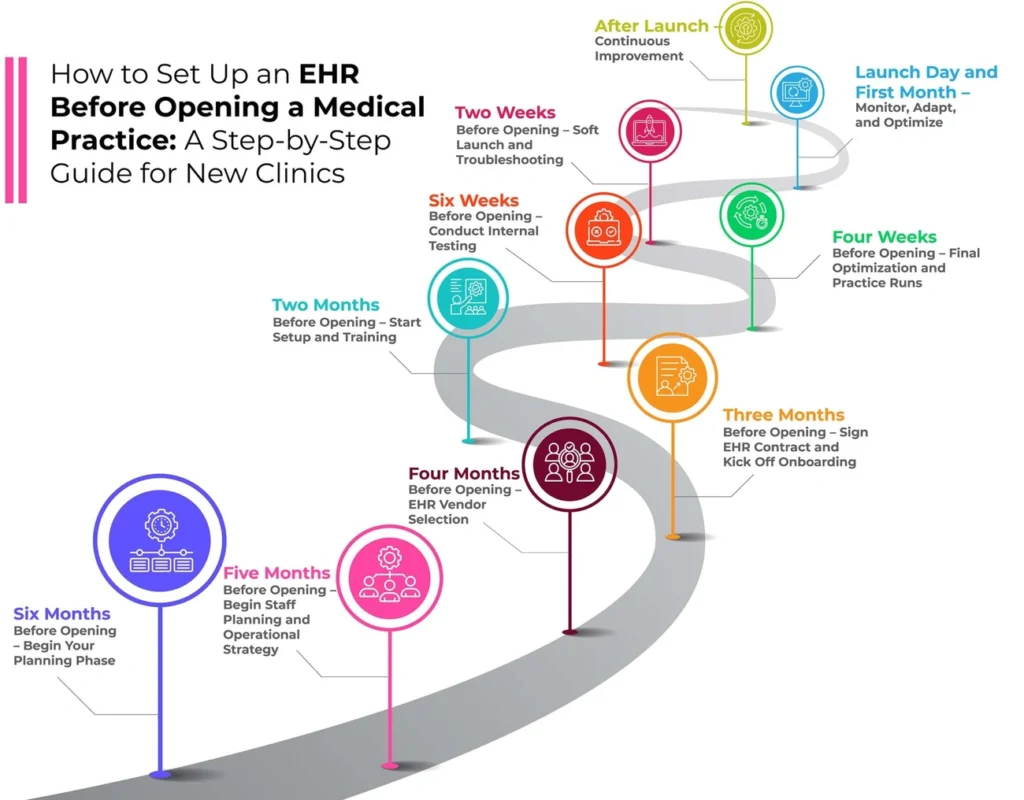Website Development for Doctors is more than just putting your practice online—it’s about meeting patient expectations. Did you know that 47% of consumers expect websites to load in 2 seconds or less? For doctors, that means your medical website needs to be fast, reliable, and designed to attract patients, not turn them away
The modern medical practice cannot survive without a competitive website. Research shows that 75% of US adults search online for health information. These potential patients represent opportunities you cannot ignore.
A well-designed healthcare website builds trust with visitors naturally. Mobile devices account for 80% of website traffic, making responsive design essential across all screens. Your website should serve as a knowledge hub that answers common questions and delivers valuable health resources.
We specialize in helping NY medical practices develop websites that transform visitors into patients. Healthcare credibility is significant to success. Patients need confidence in their provider’s expertise before making their choice.
This piece outlines the fundamentals of website development for your medical practice. You’ll discover practical steps from planning to launch that you can implement today.
1. Understand the Role of a Website in Your Medical Practice
Your medical website represents your practice’s digital face in today’s competitive healthcare world. Research shows two-thirds of patients now use the internet to find health information during their medical trips. NY doctors can’t treat a professional website as optional anymore – it’s become a necessity.
Why every NY doctor needs a website
Your practice stays invisible to about 70% of adults who look online for healthcare information without a medical website. Our business helps medical practices in New York’s crowded market to shine through expert website development. A professional website builds patient trust and makes it easier for people to find you when they need care.
Nearly 80% of potential patients start looking for healthcare providers on Google. A well-laid-out website will give you visibility in these searches. People often look up their symptoms first before deciding which type of doctor they need. Your website can connect these patients with your medical expertise.
Benefits of a strong online presence
NY medical practices get several advantages from a strong online presence:
- Boosted credibility – Professional websites help show your expertise and build trust. Patients tend to choose doctors who have a strong online presence.
- Better patient communication – Websites are the quickest way for patients to find your practice hours, location, and services. They can book appointments and reach you from home too.
- Smart marketing – Your website shows your services, specialties, credentials, and patient reviews to more people. This helps you attract new patients and expand your practice.
- Better reach – Your practice information stays available 24/7, so patients can find you whenever they need help.
Our business knows NY’s competitive healthcare environment needs smart website development that works hard, not just looks good.
How patients use healthcare websites
About three-quarters of internet users search for health information online. The sort of thing I love is that 70% of patients want their doctors to suggest reliable online health resources, but only 4% get these suggestions. This creates a great chance for your practice.
Patients want active roles in their healthcare decisions now more than ever. Your website helps them achieve this by offering educational resources, answers to common questions, and easy appointment scheduling. Patients often bring online information to their appointments. Your website becomes part of the doctor-patient relationship.
Healthcare websites give patients round-the-clock access to information, help them learn more, reduce their worries, and lead to better in-person discussions. We create medical practice websites that meet these patient needs while maintaining HIPAA compliance.
We help NY medical practices build stronger patient connections through website development. A thoughtfully designed healthcare website works as both an information hub and patient acquisition tool, making it vital to your practice’s growth plans.
2. Plan Your Website Strategy Before Development
Medical website planning matters just as much as building it. A clear strategy will give you the best chance to reach the right patients and achieve your practice goals. Research shows 77% of patients search online for doctors. This makes proper planning vital to your success.
Define your goals and services
Your website needs clear objectives from the start. Think about what you want your site to accomplish. Do you aim to increase patient volume, build brand awareness, or improve patient communication? Knowing your main goal is your first step to determine what belongs on your site.
We help NY medical practices create website goals that line up with their broader practice objectives. Here are some common medical website goals to think over:
- Streamline appointment scheduling (39% of patients want easier ways to schedule appointments)
- Provide patient education resources
- Showcase your medical expertise and credentials
- Build trust with potential patients
- Improve local visibility in search results
List the specific services you offer. Showcase specialties that set your practice apart from others in New York. Healthcare web development works best when patients clearly understand if you’re the right provider for their needs.
Identify your target patient base
Your medical practice website design needs a clear picture of who you want to reach. Focus on specific patient groups instead of broad marketing. Build patient personas based on:
- Age ranges and demographics
- Common health concerns and conditions
- Insurance coverage and financial considerations
- Geographic location within New York
- Digital habits and priorities
Targeted marketing helps you address specific wants and needs of different patient groups better. To name just one example, parents with young children often look for pediatric services and vaccinations, while older adults search for specialized care.
Our team analyzes your ideal patient profiles to create a website design that appeals to your target audience. This focused strategy works better than mass marketing.
Research competitors in New York
Search result rankings become more competitive each year. A competitive analysis gives an explanation about other medical practices in your specialty and area. Look at:
- Competitor website structure and content
- Services offered and their pricing
- Online presence and marketing strategies
- Patient reviews and testimonials
Most medical practices don’t deal very well with competitive analysis, which gives you an advantage. Our website development for doctors has thorough competitor research to help separate your practice from others.
New York’s medical market stands out as highly competitive. You need to know how you compare to direct competitors in Manhattan, Queens, Brooklyn, or Long Island. This knowledge reveals opportunities and gaps in the market.
Choose a domain name and hosting provider
Pick a domain name that people remember and associate with your practice. Here are some approaches:
- Practice name (healthcare-associates.com)
- Your personal name (drtomjones.com)
- Specialty focus (yourtownophthalmologist.com)
- Location-based (manhattanpediatrics.com)
Keep domains short and easy to spell without hyphens. Try to get a “.com” domain since people know it best.
Avoid using your web design company’s hosting services. This creates dependency and costs more ($70-100/month through agencies vs. $6-20/month with independent providers). Your hosting quality substantially affects your website’s speed and reliability, which influences both user experience and search rankings.
Our business suggests registering hosting in your name to keep control of your digital assets. This strategy prevents vendor lock-in and lets you work with different marketing partners later.
3. Build the Foundation: Design and Technical Setup

Image Source: DocVilla
Your medical website’s technical foundation plays a vital role in patient service. Research shows 82% of patients look online for healthcare providers. A solid foundation makes all the difference.
Select a CMS for healthcare web development
The right content management system (CMS) forms the backbone of your medical website. The best CMS will balance user-friendliness with healthcare features you need:
- WordPress: This platform runs over 40% of websites worldwide and lets you customize extensively
- Drupal: Perfect for complex healthcare systems that need multiple features
- HubSpot: Comes with built-in CRM tools to manage patients
We recommend WordPress to NY medical practices because it’s flexible and has strong developer support. But standard WordPress needs extra security features to meet HIPAA requirements.
Ensure HIPAA and ADA compliance
Medical websites collecting patient information must follow HIPAA guidelines. Here are the protection measures you need:
Your forms need encryption, and vendors handling Protected Health Information (PHI) must sign Business Associate Agreements (BAAs). SSL certificates should protect data moving between users and your website.
The site needs ADA compliance to help patients with disabilities. Features like screen reader support, keyboard navigation, and proper text contrast are vital. These accessibility features help you reach more patients and reduce legal risks.
Create a mobile-friendly and responsive layout
Mobile devices now account for over 90% of global internet usage. Your website should adjust automatically to fit any screen – desktop, tablet, or phone.
Responsive design makes elements move based on screen size, so patients can access your medical website from any device. We build responsive layouts that work great on mobile with easy-touch interfaces and quick loading speeds.
Use clean navigation and fast-loading pages
Navigation matters – 94% of people say it’s the most important website feature. A logical site structure and intuitive menus help organize your content. Breadcrumbs and consistent menu placement help patients find what they need.
Page speed affects user experience and search rankings. Your medical website needs optimized images, minimal CSS files, and content delivery networks. These improvements mean faster loading times, so patients stay engaged instead of leaving slow pages.
Incorporate appointment scheduling and contact forms
Scheduling tools let patients book appointments anytime without calling. Add a scheduling widget that works with your practice management system and shows when you’re available.
Your site needs HIPAA-compliant contact forms for secure patient information collection. These forms should encrypt data and display proper privacy notices. We make sure all patient communication channels stay secure and simple to use.
4. Create Content That Builds Trust and Ranks Well
Medical website content turns your digital presence from a simple brochure into a patient-attracting powerhouse. Patients make quick decisions – they judge your website within 5 seconds. We help NY medical practices build content that creates instant trust and performs well in search results.
Write clear, patient-focused content
Medical information can be complex. Your content should help patients understand it easily. Short paragraphs and everyday language work better than medical jargon. In fact, finding reliable health information should be the simplest part of a patient’s experience.
Good healthcare content:
- Makes reading easy
- Links pages together smartly
- Targets your specific patient groups
- Speaks in the right way
We help NY doctors create content that matches the patient’s experience and makes finding relevant information simple.
Use SEO best practices for local visibility
Local SEO connects patients with your practice right when they need you. 98% of U.S. consumers read online reviews for local businesses. Smart optimization for local search terms can make your practice much more visible.
Each specialized service needs its own page instead of one generic “services” page. Local healthcare tips in your blog posts can strengthen your local SEO strategy. New content makes a difference – five fresh monthly reviews matter more than 500 old ones.
Add doctor bios, services, and FAQs
Most patients (92%) read doctor bios before making their first appointment. Your bio should list:
- Clinical specialties and board certifications
- Education and medical training
- Languages spoken
- Professional philosophy
FAQ pages are vital for healthcare websites that want new patients. These pages boost SEO with valuable search terms and let patients ask sensitive questions they might not bring up face-to-face.
Include testimonials and trust signals
Patient testimonials prove your credibility. Research shows that website conversion rates jump 270% when you display customer reviews. Just remember to get written permission first for HIPAA compliance.
Trust signals that matter include:
- Real staff headshots
- Board certifications and credentials
- HIPAA badges on secure forms
- Google reviews
Use high-quality images and videos
Doctor profiles with photos get twice as many views. Most people (77%) look for photos or videos of doctors before scheduling appointments. Real photos of you, your space, and your team work better than obvious stock photos.
Video content creates stronger connections with patients. Medical animations explain complex procedures in simple ways, and video testimonials rank as the top content marketing tool for 89% of marketers.
5. Launch, Promote, and Maintain Your Website
Your medical website needs full testing to work perfectly for patients. We help NY medical practices create websites that leave lasting first impressions.
Test for speed, mobile, and accessibility
Patients leave websites that take more than three seconds to load. Google PageSpeed Insights will help you spot performance problems. Your website must work smoothly on all devices because mobile phones now account for over half of all searches.
Screen readers and keyboard navigation tests will keep your site ADA compliant. This protects you from lawsuits and makes your site available to all patients.
Promote via social media and local SEO
Local SEO makes it easy for patients to find you when they search for nearby medical services. Start with these steps:
- Create a Google Business Profile with accurate information
- Keep your NAP (name, address, phone) consistent in all directories
- Add location-based keywords to your content
Social media strengthens patient relationships. Health tips and appointment updates will establish you as a trusted expert.
Track performance with analytics tools
HIPAA-compliant analytics tools like Freshpaint or Siteimprove help monitor your website performance. These tools track visitor behavior while respecting patient privacy regulations.
Update content and security regularly
Fresh content improves search rankings and keeps your site relevant. Regular security updates protect your patient information effectively.
Need professional website development for doctors in NY? 🩺 Mehnav builds modern, SEO-optimized medical websites that attract more patients and build trust. Let’s grow your practice online 👉 mehnav.com
Conclusion
A professional medical website serves as your practice’s digital foundation in today’s healthcare world. Patients expect to find you online, research your services, and schedule appointments easily. Creating a website needs careful planning – from setting clear goals to understanding your target patients in New York.
We’ve witnessed how the right website can change medical practices. Both technical implementation and visual design play crucial roles. A user-friendly CMS, HIPAA compliance, and mobile-responsive layouts that load fast are essential elements.
Content plays a vital role in healthcare websites. Medical expertise must blend with clear, patient-friendly language. Trust signals like credentials, testimonials, and professional photos help build credibility with potential patients.
Your website demands regular upkeep after launch. Performance metrics reveal what works and areas that need improvement. Your online presence grows with your practice.
The digital healthcare experience begins with your website. Patients form opinions about your practice based on their online interactions. Our business creates websites that turn visitors into patients through effective design and content.
Need professional website development for doctors in NY? 🩺 Mehnav creates modern, SEO-optimized medical websites that attract more patients and build trust. Let’s grow your practice online 👉 mehnav.com
Key Takeaways
Building a successful medical website requires strategic planning, technical expertise, and patient-focused content to compete in New York’s healthcare market.
• Plan strategically before building – Define clear goals, identify target patients, research competitors, and choose the right domain and hosting to create a focused website strategy.
• Prioritize mobile-first design and compliance – Ensure HIPAA/ADA compliance, responsive layouts, and fast loading speeds since 80% of users browse on mobile devices.
• Create trust-building content – Write patient-friendly content, optimize for local SEO, include doctor bios and testimonials, and use high-quality images to establish credibility.
• Test thoroughly before launch – Verify speed, mobile functionality, and accessibility, then promote through local SEO and social media while tracking performance with analytics.
• Maintain and update regularly – Keep content fresh, security current, and monitor performance metrics to ensure your website continues attracting and converting patients.
A well-executed medical website serves as your practice’s digital foundation, helping you capture the 75% of adults who search online for healthcare information and convert them into loyal patients.
FAQs
Q1. How much does it typically cost to develop a medical practice website? The cost of developing a medical practice website can vary widely, ranging from $5,000 to $100,000. Factors affecting the price include design complexity, custom features, and the level of functionality required. A basic website might cost around $2,000-$3,000, while a more comprehensive site with advanced features could be in the $50,000-$100,000 range.
Q2. What are the essential features to include in a medical practice website? Essential features for a medical practice website include a mobile-responsive design, clear navigation, doctor bios and credentials, service descriptions, patient testimonials, online appointment scheduling, contact forms, and HIPAA-compliant security measures. Additionally, including educational content and FAQs can help build trust with potential patients.
Q3. How can I ensure my medical website is HIPAA compliant? To ensure HIPAA compliance, encrypt all form submissions, use SSL certificates for data transmission, obtain Business Associate Agreements from vendors handling Protected Health Information, and include appropriate privacy notices. It’s also crucial to regularly update security measures and train staff on proper data handling procedures.
Q4. What are effective ways to promote a medical practice website? Effective promotion strategies include optimizing for local SEO, creating and maintaining a Google Business Profile, consistently updating social media with health tips and practice news, encouraging patient reviews, and considering targeted online advertising. Regular content updates and blog posts can also improve search engine visibility.
Q5. How often should I update my medical practice website? It’s recommended to review and update your medical practice website content at least quarterly. This includes refreshing service information, adding new blog posts or health resources, updating staff bios, and ensuring all contact information is current. Additionally, security measures and technical aspects should be reviewed and updated regularly to maintain optimal performance and protection.


